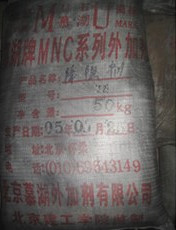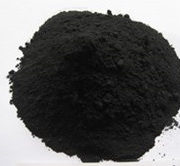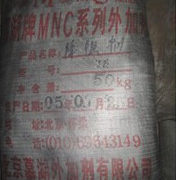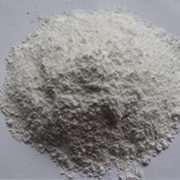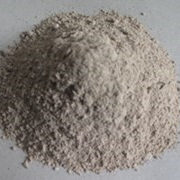Grounding Resistance-reducing Admixture (MNC-JV)
Product Name: Grounding Resistance-reducing Admixture (MNC-JV)
Type: MNC-JV
Package: 50 kg/bag
Grounding Resistance-reducing Admixture
MNC-JV
Description
This admixture is used for the overall solution of lightning protection, especially for lightning protection of mountains, islands, radar stations, microwave stations and communication stations, and ground connection in complex geological conditions.
Features
1) Available resistance reduction: after ion electrode is buried, ions are released into the soil to quickly militate. Especially in high soil resistivity area with many rocks, resistance reduction effect is very obvious. The resistance reducing agent after gelling is surrounded near the ground connection, the diffuser area of ground connector can be effectively increased to reduce contact resistance of grounding electrode and soil. During gelling process, liquid resistance reducing agent can produce root effect in soil to reduce impulse grounding resistance. Gel has strong capacity of water retention and absorption. Gel can make ionic conductor in resistance reducing agent fully play the role. This resistance reducing agent can make the original grounding resistance reduction be between 60% and 90% ;
2) Slow release and controlled release: conductive ions of external backfill material are supplemented with continuously and automatically releasing active conductive ions to ensure that the plasma quantity in grounding and around soil is constant. This ensures that the conductivity around soil with grounding electrode can be maintained at a high level to thus guarantee long-term resistance reduction performance of grounding electrode;
3) Deep grounding: when ions are released into soil, they can gradually go deep into soil to reach ten to several times length of electrode and make resistance reduction effect of deep grounding;
4) Conductive anti-corrosion: fine material of electrode, subsequent supplementary process for polar tube’s inner wall and outer wall, selection for ion-generating material and external filler material all ensure electrical conductivity and corrosion resistance. The pH value of this resistance reduction agent is 8, which is slightly neutral to alkali and has passivity protection, corrosion protection and covering protection for grounding. Secondly, this resistance reducing agent contains zinc and its compounds to make cathodic protection for grounding steel. Therefore, that earth pole is wrapped with this resistance reducing agent could not only reduce resistance, but also be effective to prevent corruption of grounding network. Grounding network’s service life is up to 40 years;
5) Grounding stability: If ions are released into soil, grounding resistance is ensured to be stable, regardless of weather conditions, seasonal changes or rainfall changes. The conductivity of this resistance reducing agent is not influenced by acid, alkali, salt, temperature and humidity. The conductivity can not be reduced because of falling water level or dry weather. Grounding electrode (wire) and grounding network wrapped by this resistance reducing agent are less affected by weather, season, environment, soil and the other factors. Because of Rmax / R≤1.36, the grounding resistance is stable;
6) Construction is simple:compared to traditional grounding mode or other grounding mode, the amount of materials, construction and engineering is greatly reduced and a lot of project costs are saved.
Main technical parameters
|
No. |
Item |
Basic requirements |
Test results |
|
1 |
Room temperature resistivity |
ρ≤5Ω.m |
ρ≤0.72Ω.m |
|
2 |
Physical and chemical properties: 1) dehydration 2)hot and cold cycle 3) water immersion |
ρ≤6Ω.m |
ρ=6Ω.m |
|
3 |
Frequency current tolerance |
ΔR%≤20% |
ΔR%=11.5% |
|
4 |
pH value |
pH=7~9 |
pH=8 |
|
5 |
Resistance reducing agent’s corrosion for grounding steel |
Average surface corrosion rate ≤0.03㎜ / year |
Galvanized round steel: 0.0022㎜ / year, Galvanized flat steel: 0.0026㎜ / year |
|
6 |
Effect stability of resistance reduction |
After taking into account climate impact, R * max / R * ≤1.5 |
R*max/R*≤1.36 |
Applications
This product can be used for building grounding, lightning protection grounding, anti-static grounding, AC ground, DC ground, protective grounding, signal grounding, and the other grounding systems.
Especially suitable for:
1. Grounding network with low grounding resistance;
2. Grounding network in a small section of city;
3. Grounding network in high soil resistivity areas of mountain, island, pebble and desert;
4. Grounding network in high corrosion areas of beach and saline-alkali land;
5. Grounding network in severe cold areas;
Usage and dosage
1) Usage: When being used, liquid in drum could be poured into a big container, where it is easy to stir. Then, powder (one drum liquid for one bag powder) is poured in proportion, and quickly stir with a wooden stick until the solution begins to be thick (whitish). Quickly pour it around grounding electrode (wire), and wait until security polymerization. After flexible gel is formed, select fine soil to cover and then add another soil compaction;
2) Recommended dosage: whenρis ≤500Ω.m, 12.5㎏ / m is for level grounding and 25kg / m is for vertical grounding. When ρ is > 500Ω.m, a strong penetration is used. When the solution soon thickens
(3 ~ 5min), it is poured on grounding electrode (wire) to complete the polymerization during infiltration and form the “root effect.” Dosage: 25 kg / m for level grounding and 50㎏ / m for vertical grounding.
Precautions
1) If the solution is spilled on hand, face or eye during operation, could rinse with water;
2) Shake well before use. Before the solution is poured into big container, flip and shake a few times in advance to make material mix, and then pour into big container;
3) When applied at low temperatures, stirring and polymerization time becomes longer, and this does not influence the product performance. If necessary, the solution can be warmed to 10 ~ 20 ℃, and then stir to shorten the polymerization time;
4) When applied at higher temperatures, stirring and polymerization time is shortened, and then should speed up the construction schedule







